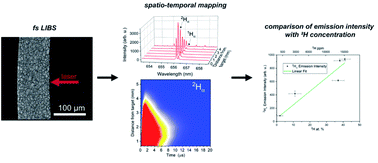Detection of hydrogen isotopes in Zircaloy-4 via femtosecond LIBS
Abstract
The analysis of hydrogen isotopes (1H, 2H, and 3H) is crucial to several applications, including nuclear forensics and safeguards, characterization of nuclear fission and fusion reactor materials, geochemistry, and space exploration. Laser-induced breakdown spectroscopy (LIBS) is a promising tool for the real-time analysis of hydrogen isotopes. However, the accurate, quantitative analysis via LIBS can be challenging due to 1H contamination on sample surfaces, residual 1H in the analysis environment, minor amounts of solute 1H, and spectral line broadening. Here, we characterize femtosecond laser induced plasmas from Zircaloy-4 targets with varying 1H and 2H concentrations in a He gas environment via spatially and temporally resolved optical emission spectroscopy. The impact of varying ambient gas pressure, the spatial distribution, and temporal histories of species viz., 1Hα, 2Hα, and Zr I on Zircaloy-4 plasma spectral features are reported. 1Hα and Zr I emission features are found to have different ambient pressure dependencies and are separated in both space and time in the laser induced plasmas. Lastly, the measured 2Hα emission intensities via femtosecond LIBS for a wide range of 2H concentrations in Zircaloy-4 samples showed a linear trend when plotted versus known 2H concentration.



 Please wait while we load your content...
Please wait while we load your content...